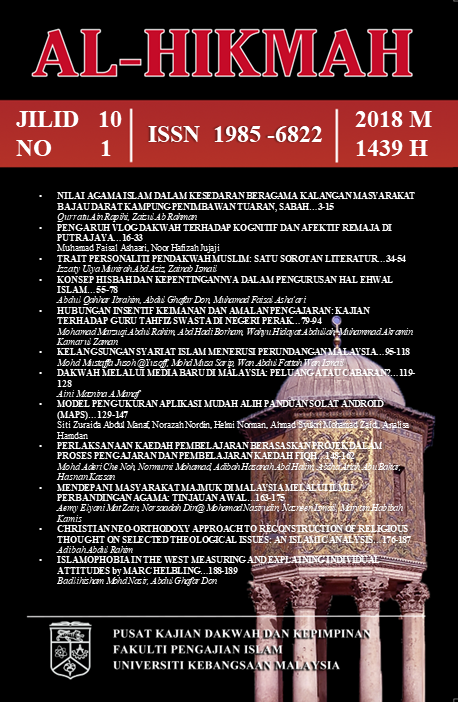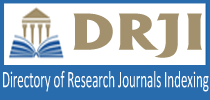CONCEPT AND IMPORTANCE OF HISBAH IN THE MANAGEMENT OF ISLAMIC AFFAIRS
Konsep Hisbah dan Kepentingannya dalam Pengurusan Hal Ehwal Islam
Abstract
Concept and Importance of Hisbah in The Management of Islamic Affairs
Implementation of hisba is a practice in the management oversight that impressed with the concept of Islam al-amr bi al-ma ᶜruf and al-nahyi ᶜan al-munkar and its implementation has been started since the first days of Islam. In summary scope is so vast hisbah concept covering aspects of religious, political, social and economic. The objective of this paper is to study the hisbah concept and its importance in managing Islamic affairs. The writing is already using content analysis methods such as the enactment of a specific document, papers, journals, and books related. The results showed that hisbah are formed based on an understanding of the elements al-amr bi al-ma ᶜruf and al-nahyi ᶜan al-munkar, which is the basis for the implementation and management of hisbah. Hisbah function is also very important to establish and build management of Islamic affairs viable internally and externally in accordance with current developments. Thus, studies and ongoing research should be done to the process of strengthening the implementation of hisbah concept in the management of Islamic affairs in the future, namely in terms of organizational structure, problems and challenges.
References
Abdul Hasib Ridhwan. 1990. Dirāsāt fi al-hisbah min nahīyatain: al-tarikhiyyah wa al-fiqhiyyah. Kaherah: al-Matbaah al-Islamiyyah al-Haditsah.
Abdul Karim Zaydan. 2010. Usul al-dacwah. Beirut: Muassasah al-Risalah Nasyirun.
Abdul Karim Zaidan. 2011. Nizām al-qadha’fi al-syariah al-islamiyyah. Beirut: Muassasah Risalah Nashirun
Abu Mazaya dan Abu Izzat. 2015. Fiqh jenayah islam. Batu Caves: al-Hidayah Publications.
Ahmad Ibrahim Abu Sin. Terj. Abdul Rashid Ngah & Jusoh Kadir. 2002. Pengurusan dalam islam. Kuala Lumpur: Dewan Bahasa dan Pustaka (DBP).
Ahmad Redzuwan Mohd Yunus dan Anuar Puteh. 2001. Kepimpinan dan pengurusan islam. Bangi: Pusat Pengajian Jarak Jauh UKM.
Ahmad Shahbari Salamon. 1986. Islamic concept of management. Islamiyyat (7) 67-72.
Akademi Pengurusan YPEIM. 2005. Pengurusan dalam Islam: menghayati prinsip dan nilai qurani. Kuala Lumpur: Akademi Pengurusan YPEIM Sdn. Bhd..
Al-Ghazali, Abu Hamid Muhammad. 1980. Ihya Ulum Al-Din, Jil 2. Beirut: Dar Al-Rasyad Al-Hadithah
Al-Mawardi. 2006. al-Ahkām al-sultaniyah. Kaherah: Dar al-Hadis.
Anon. 1973. al-Munjid. Beirut: Dar al-Masyriq.
Anwar Ahmad Qadri. 1980. Justice in historical islam. Lahore: Sh. Muhammad Ashraf.
Auni Abdullah. 2000. Hisbah dan pentadbiran negara. Kuala Lumpur: IKDAS Sdn. Bhd..
Auni Abdullah. t.th. Pengurusan islam: potensi dan cabaran. Kuala Lumpur: Darul Fikir Sdn. Bhd..
Azrin Ibrahim. 2014. Amalan hisbah di Malaysia. Kuala Lumpur: Dewan Bahasa dan Pustaka (DBP).
Enakmen Pentadbiran Agama Islam (Negeri Selangor) Pindaan 2008.
Hamid Muhammad Abu Talib. 1982. al-Tanẓim al-qadhā’ī al-islamī. Misr: al-Matbaah al-Saadah.
Ibrahim Anis et.al. 1972. al-Mucjam al-wasīt. Kaherah: t.penerbit.
Mardzelah Makhsin. 2008. Hisbah: sistem pengawasan dan etika pengurusan Islam. Sintok: Penerbit Universiti Utara Malaysia.
Muhammad Yusuf Khalid. 1998. Hisbah dan peranannya dalam pengurusan pembangunan Islam. Dlm. Abdul Ghafar Hj. Don & Shamsul Bahri Andi Galigo (pnyt.). Dakwah menjana masyarakat madani. hlm. 110-117. Bangi: Jabatan Pengajian Dakwah dan Kepimpinan, Fakulti Pengajian Islam UKM.
Mustafa Daud. 2000. Pengurusan Islam: falsafah, ciri dan profesionalisme. Dlm. Abdul Ghafar Don et.al (pnyt.). Dakwah dan pengurusan Islam di Malaysia: konsep dan pelaksanaan. hlm. 29-36. Bangi: Penerbit Universiti Kebangsaan Malaysia.
Perlembagaan Persekutuan Malaysia 2010
Razaleigh Muhamat@Kawangit. 2005. Pengurusan hal ehwal Islam di pusat Islam IPT. Bangi: Pusat Islam Universiti Kebangsaan Malaysia (UKM).
Shauqi Abu Khalil. 2010. al-Hadharah al-carabiyyah al-islamiyyah. Beirut: Dar al-Fikr al-Muaashir.
Usamah Abdul Sami’. 2011. al-Hisbah fī al-islam wa dauruha fī himāyati al-mustahlik. Misr: Dar al-Kutub al-Qanuniah.
Copyright (c) 2018 Al-Hikmah

This work is licensed under a Creative Commons Attribution-NonCommercial-NoDerivatives 4.0 International License.
Authors retain copyright and grant the journal right of first publication with the work simultaneously licensed under a Creative Commons Attribution License (CC BY-SA 4.0) that allows others to share the work with an acknowledgement of the work's authorship and initial publication in this journal.








